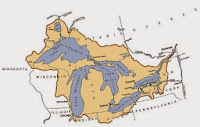Attending a wedding of this tradition was a first for me, and as I failed to find a good account of the various rituals involved, I thought it might be nice to create one. If I've gotten some of this wrong, definitely let me know!
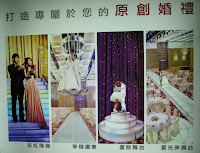
Wandering around Taipei, I kept seeing the same adverstisement for a wedding venue. It made me wonder, is this what a Taiwanese wedding looks like? I mean, would our friends dance on a giant cake? arrive at the reception by descending from the sky on a shiny platform? I sure hoped so!
We headed to the
Silks Palace at the National Palace Museum in Taipei for the big event.
As the wedding we attended had guests coming from far and wide, the bride and groom opted to have their engagment ceremony and wedding all in the same day and in the same location. Cleverly, a lot of the steps and location changes were represented by changing rooms within the venue; although as a lot of the dialogue and instruction was in Mandarin, my interpretation may not be 100%.
As I understand it:
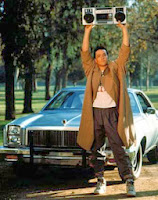
The engagement process is kicked off when the groom shows up at the bride's house, possibly with six cars, a dowry in a red envelope, and a boom box playing Peter Gabriel's, "In Your Eyes".

Really, It looks a bit more like this:
(Lots of red ribbons for luck!)
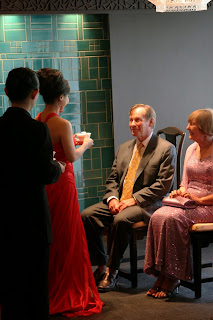
Assuming that all goes well, the bride goes with the groom, the six cars, and the boombox to the groom's parents' home, where she makes tea for them. Assuming the tea is up to snuff, the groom's parents will express their support of the union through further contributions to the dowry in red envelopes placed atop their empty teacups.
During the engagement process, gifts of gold are given by the parents to their new daughter or son in law, an engagement ring is given (to be worn in the middle finger), and the couple to be exchange six gifts.
Numbers are very important. The six cars, the six gifts... the wedding party will consist of two or six, but mustn't have four, as fours are very unlucky.
Then, the bride's mother will consult the calendar and use the bride and groom's birthdates to determine the luckiest date for their union.
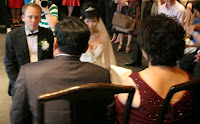
The marriage ceremony itself was very simple and beautiful. From what I gathered, it is where the parents of the bride give their final blessing, and the bride says goodbye to her parents. Traditionally, this is where the bride will leave home and join her husband's family. It was a very emotional thing to observe. I don't think there was a dry eye in the room. (I'm a sap and could take few pictures)
After that, it's festivity time!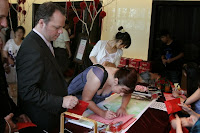
We headed up to the reception, where we, too, offered our gifts in red envelopes as well. We were advised that to not give any sum that contained a four or to give four bills.
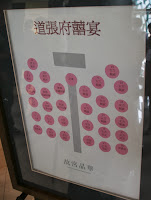
Gifts are given prior to the reception, and typically one gives a sum of money which should cover the expense of attendance at the dinner.
The money from both sides is counted and recorded in a register.
Finding our seats was a bit of a challenge on the floorplan to the right! With a little help, we made our way to our seats and settled in.
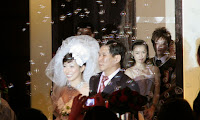
Would the bride and groom arrive atop giant cake on hydraulics?
As it happens, they didn't, but there were lots of bubbles for the bride and her father!
Traditionally, a reception will consist of a massive, multi-course feast. This one had twelve courses of wonderful food, some of which is below:
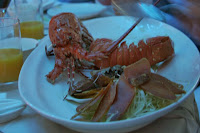
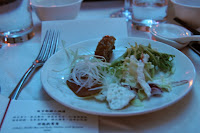
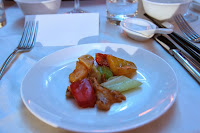
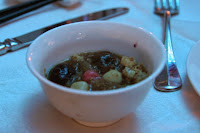
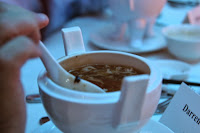
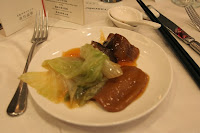
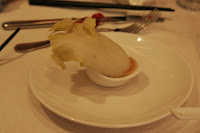
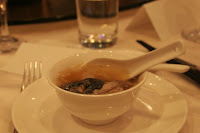
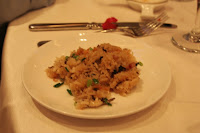
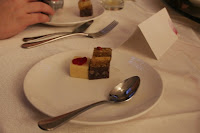
Including a little sweet for dessert!
I will go back and explain what all these dishes are, but if I don't just publish this now, I'll not do it for at least another week!
Unlike Western weddings, and much to the joy of my husband, there is no dancing.
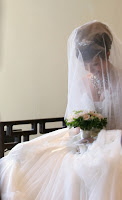
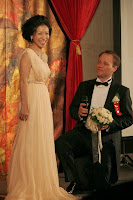
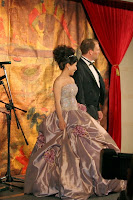
Another interesting thing about a Chinese wedding:
The bride changes her dress three times during the festivities. Dresses are rented, rather than purchased.
(This was a Western-style wedding, which means a white dress was worn.)
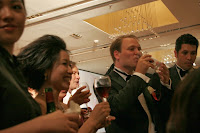
During the feast, the wedding party visits each table and toasts with them.
The toast is done with two hands, with one hand on the bottom of the glass.
As a typical wedding is very large, many people will drink juice instead, as else, the wedding party might be needed to fireman carry the new couple around.
At the end of the festivities, we found that the only guests shuffling around and awkwardly engaging in lengthy, protracted goodbyes were the westerners. The local guests took their leave, right on cue.

We headed out ourselves with
two red boxes to investigate back at the hotel...






